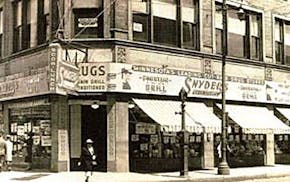Q: I'd like to have more hummingbird action at my feeders this summer. Do you have any tips for attracting more of them?
A: Hummingbirds are ferocious about maintaining a territory, so the challenge becomes how to overcome their propensity to drive off others of their kind. Having blooming plants in several garden beds (to give room for several hummingbirds to dip into flower nectar at once) is a good strategy, making sure that at least some of the blooms are shaped liked red trumpets (such as salvias), the little birds' favorite shape and color. Since hummingbirds arrive back on migration before gardens are in bloom, it helps to invest in hanging plants with many blooms, to catch their eyes. It's also a good idea to have garden plants with tiny blooms, since these attract the small insects that make up a major portion of hummingbirds' diet. Offering sugar water in several feeders hung a distance from each other should help stop one bird from driving off any and all others. And the addition of a small fountain or splash feature to your birdbath will help draw them in. Still, you may not see multiple hummingbirds until fall migration, when the birds bunch up at feeders and in gardens to prepare for their long journeys.
Nest building plans
Q: How do birds know how to build their nests?
A: Good question. For starters, each bird has its species' building plans hard-wired in its brain: Robins gather mud for a base, then add walls made of grasses, orioles weave a hanging purse-shape made from plant fibers and bluebirds carry grasses, pine needles and plant stalks to build their nests in tree holes or nest boxes. Birds are adaptable, though, and they use the materials they find close to hand, so nests may vary a bit from bird to bird. One nest-builder that doesn't stray from its species' schematics is the house wren. These tiny birds haul twig after twig into a cavity to make their distinctive nests.
Some birds find old nests a good source for building materials, such as ravens that may snatch sticks from osprey platforms and cedar waxwings mining old Baltimore oriole nests for fibers for their own nests.
Window attacks
Q: Why is a cardinal pecking at my window, over and over?
A: It's a springtime constant — birds from robins to cardinals to goldfinches and many in between, seem to attack a home's windows or a vehicle's rearview mirror in spring. Why do they do it? Because they caught a glimpse of their own reflection in the glass and, mistaking this for an invader looking to take over its territory, they spend hours each day trying to drive off the intruder. Not only is this futile, but it's wearing for both the homeowner and the bird. It can also be messy, because the bird may engage in "stress pooping." The time-honored advice is to stop the reflection, but merely drawing curtains doesn't do the job. Placing cardboard on the outside of the window will foil the bird, and wrapping a rearview mirror in a plastic bag for the duration will stop the mess on a car or truck. It's a kindness for the bird, too, since they wear themselves out and sometimes injure themselves in these futile battles. Once spring's hormones taper off, the attacks will end, as well.
Spying on crows
Q: I noticed a crow flying with long sticks in its beak, but I've never seen a crow flying into or out of a nest. Where do they typically place their nests — I'd like to spy on them.
A: I like to keep my eyes on crows, too, because they're always up to something interesting. Crows are likely to build their stick nests on branches near the top of tall evergreen trees. You might spot adults coming and going from such a tree as they build their nest and then raise their brood of crowlets.
Birds feel tree loss
Q: The city recently cut down many mature trees in my neighborhood. Will this affect bird behavior?
A: Yes, I think you'll see birds changing their behavior after the loss of those trees. They doubtless perched in the tree canopies, built their nests on twigs or branches and fed on tree buds and any seeds or nuts the trees produced. When leafed out, trees provide shelter from storms and predators, too. It's always sad to lose big trees: I had to have an old silver maple tree taken down two years ago, and even two years later I'm seeing fewer birds at my feeders. Also, I no longer see brown creepers and nuthatches, birds that mined the trunk bark for insects. Not to mention the flying squirrels have disappeared.
The best seed
Q: How do I determine if I am feeding the best type of sunflower seeds? Labels on bags tend to tell how much protein is in a seed, but I'd think the size or toughness of the shell would be a factor since if a bird can't crack a shell, the seed itself is of little value.
A: This is an excellent question and the answer is to seek out seeds labeled black oiler sunflower seeds. These are preferred by the majority of seed-eating birds, and as you noted this is partially because they are easy for many kinds of beaks to open. They're also high in oil and provide a great deal of energy.
Sneak attack
Q: I thought rabbits or squirrels were the ones eating my beautiful crocuses this spring, but then I spied a goldfinch tearing up the spring flowers one morning. Is this bird the culprit?
A: Goldfinches (and house finches) live on a diet almost entirely made up of seeds, but they do have a taste for nectar and sometimes visit hummingbird feeders to drink the liquid. I'm not sure if the crocus-eating finch was after nectar or roughage, but other readers have reported observing house finches and goldfinches stripping kale, Swiss chard and dandelion greens in summer, as well.
Cooper's hawks. Really?
Q: I saw a Cooper's hawk carrying twigs by its feet in early April to a tree in a park. We live in a residential area, so they couldn't be building a nest around here, could they?
A: Yes, a pair of Cooper's hawks may very well have been building a nest in your neighborhood. These crow-sized raptors, more commonly found in forests, increasingly are raising their families in cities and suburbs. Why the change? Bird feeders attract high numbers of birds, and Cooper's hawks eat birds, usually preying on larger species like doves, pigeons, flickers and jays, but I've seen Cooper's hawks snatch starlings and cardinals. And they'll also take juncos and house sparrows, something I've seen in my own backyard.
If you don't want a raptor hunting through your property, the standard advice is to take down your feeders for a week or more. When your songbirds move elsewhere to feed, the hawks may hunt elsewhere for their meals. But if the hawks are nesting nearby, I suspect they'll return once you put your feeders back up, since they have hungry mouths to feed back at their nest.
St. Paul resident Val Cunningham, who volunteers with bird organizations and writes about nature for local, regional and national newspapers and magazines, can be reached at valwrites@comcast.net.

When West Seventh Pharmacy closes, St. Paul will lose a piece of history and personal care

John Cusack dishes on 'High Fidelity' at Minneapolis screening

For 'Legally Blonde' star, 'being underestimated is her secret superpower'

Restaurant openings and closings in the Twin Cities

